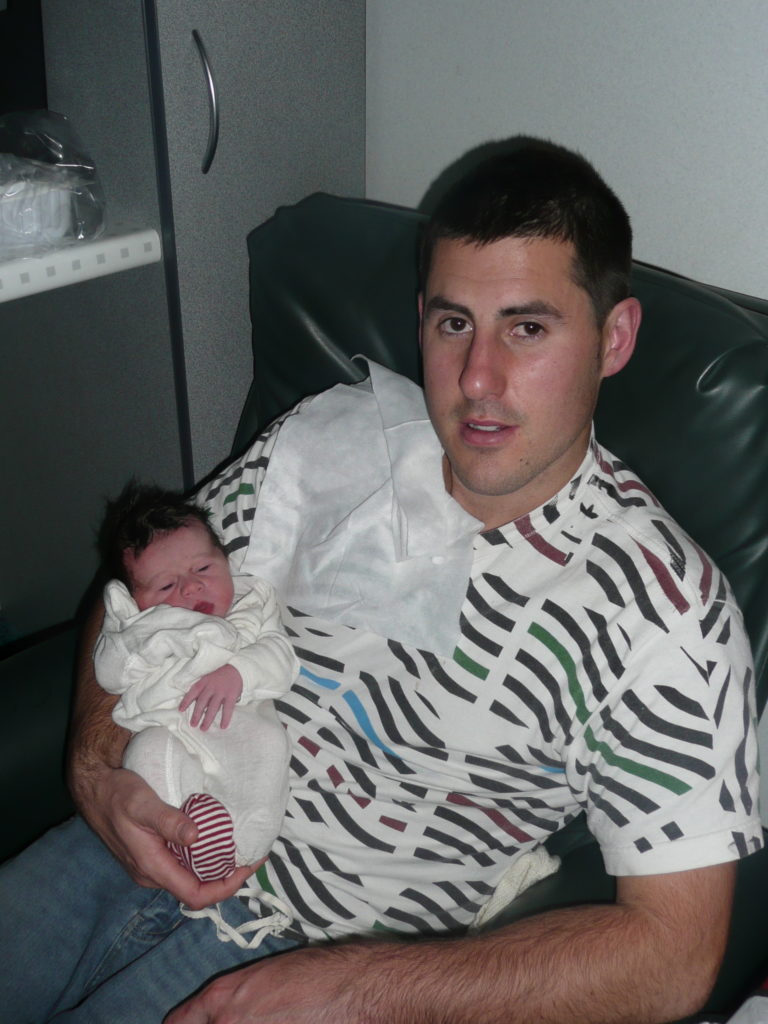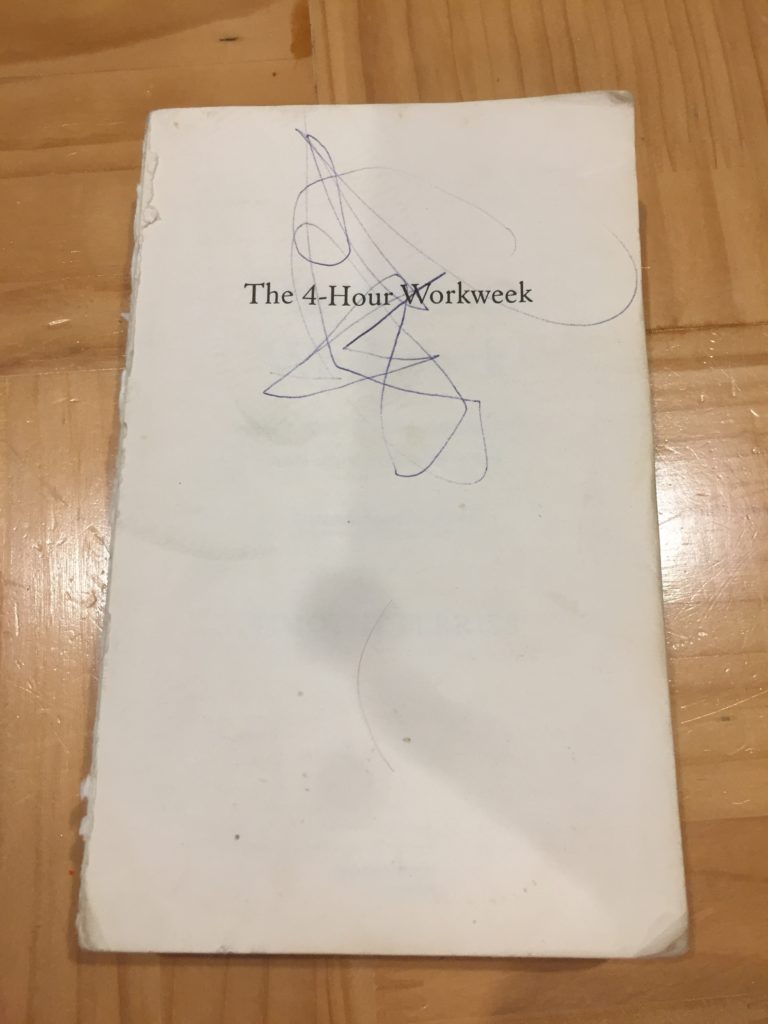Back in 2012 Katie was 26, I was 27 and we had been married for five and a half years. After travelling for 16 months on one way tickets we came back home to good ole Upper Hutt. The previous year we had picked up the Silverspoon (a local restaurant that was about to close) for a bargain price.
2 life changing events happened that year.
My first son, Jacob, was born and
I started reading the ‘Four Hour Work Week’ by Timothy Ferriss (4HWW).
June, 2012.
It was June 19, Katie wasn’t planning to have a baby, at least not right now. She was still working full time at the Silverspoon as well as going to the gym
Still half asleep I took out all the notes the midwife had given us and we concluded she was starting to have contractions. We nervously waited to see what happened. At 6 am we took a walk around the block and then I rang the midwife to fill her in.
I was still doing my building apprenticeship (as well as owning the restaurant) and I remember texting Matt, my building boss, to say “I think we are going to have a baby today, won’t be able to make it into work”. At
Katie was doing awesome and we thought it was going to be a normal quick birth. Around 11 am the real contractions started and it was time to push. Then things took a turn and it got pretty bad near the end. Katie had been pushing for a bit, but the baby seemed stuck. The Midwife started monitoring the baby’s heart rate, and you could tell by the look on her face that it wasn’t good. The emergency bell was pressed, the room filled with doctors and nurses.
I vividly remember a large pair of scissors and a little suction cup. They proceeded to cut Katie and pull the baby out of the birth canal. It was like a horror movie! We had opted for a surprise and were anxiously waiting to find out if we had a boy or a girl. We were also filled with worry and fear about the health of the baby.
Around lunch time on June 20th Jacob was born. This tiny little human, formed inside my wife and grown over 9 months. Despite his rough
For us, our life had just been turned upside down.
We have a son! I am a dad!
Instantly my perspective changed. Work, the Silverspoon and the stress of all the projects I had been working on melted away. All I knew was there was a tiny little person depending on us and I wanted to spend every minute I could with him.

The Four Hour Work Week – 4HWW
There is no doubt – the 4HWW is my number one recommended and gifted book.
Before you think I am some Fanboy know this – the first time I noticed the 4HWW I laughed and put it back on the shelf. I thought it was a joke. I remember picking it up and glancing at the cover in Whitcoulls Upper Hutt. This was when it first came out in 2007. I read the front and back of the book and put it back without a second thought.
At the time I prided myself on being the hardest worker. Work hard and all our problems will be solved, I thought this was the key to success. Don’t get me wrong, hard work is important, but I have since learned it’s also important to stop and reflect on what you’re working hard at.
It wasn’t until years later in 2012 I came across the 4HWW again. Katie was shopping and like usual I was killing time in the book shop. I picked up the book and flicked through, there was a page on outsourcing that caught my attention. An hour later I was still standing in the aisle reading. This time I purchased the book and quickly devoured the contents. It blew my mind.
It felt like it had been written just for me, in this exact moment. At the Silverspoon we had just come to the realisation that our plan to grow sales at the restaurant was not working. We weren’t sure what to do next. I could see parallels between these stories that Tim was writing about his business in the States and the problems I was facing at the Silverspoon.
There was a common misconception, including my own, that this book was only for knowledge-based workers in Silicon Valley. Here I was with a traditional service-based, small business in Upper Hutt, New Zealand. Not a tech company, not a start-up, or one that you can typically turn virtual.
An important note to clarify before you get too far in. The ‘Four Hour Work Week’ is not about sitting around doing as little as possible. It’s not about running away to live on the beach, at least that’s not my take on it. It’s about reducing the things you “have to do” to the smallest amount of time possible, so you can focus on the things you want to do. It can mean keeping the same job, living in the same city, but being flexible to work on terms that suit you better.
The book is broken down into 4 main sections with the acronym DEAL. I will briefly explain each section and how it made a difference to our journey at the Silverspoon.
D for Definition
E for Eliminate
A for Automate
L for Liberate

D for Definition.
This section starts with a story about a multi-millionaire who is unhappy. The term “New Rich” is introduced and over the next few chapters there are a series of examples, and questions to ask yourself.
Imagine you’re “rich”, what would you do? Why are you not doing this right now?
The ‘Define’ section made me realise we didn’t have a real goal. Sure we had a goal to grow the business to one million in sales, but we hadn’t thought past that.
What will we do when the business is making one million in turnover?
Why one million? What profit do I think that will give us?
What will we do with the profit?
After going through these questions we came up with a different figure, we wanted the business to make 100k bottom line. At the time we were living off about $500 a week, so we figured 100k would 4x our income and give us financial freedom. We also set some non-financial goals, how we wanted to spend our time, things we wanted to do etc.
It turns out we didn’t actually need to crack 1 million in sales to achieve this either. Within a year and a half we had achieved our profit target on approximately only 750k of sales.
E for Eliminate
The opening words of this section say it all: “Just a few words on time management. Forget all about it. In the strictest sense you shouldn’t be trying to fill every second with a work fidget of some type”.
And shortly after under the subtitle: Being Effective vs Being Efficient
“1 Doing something unimportant well does not make it important
2 Requiring a lot of time does not make a task important”
This may sound obvious, but you have to put your small-business-owner hat on for a second.
When you own a small business it’s very easy for it to quickly consume your entire life. You lie in bed at night thinking about it and all the things you will do to make it better. You’re physically present at family events but mentally your mind is worrying about the big booking tonight and how your staff will handle it.
You miss out on special events because the business “needs you”. You convince yourself that being a business owner is worth this consumption and it will pay off.
Every time you see someone you know, (or even those you don’t know), at the shops or a party, they ask you about it. They proceed to tell you who they know has recently been there and whether that experience was good or not. Followed by what they think you should put on the menu, because they have been eating 3 meals a day for their entire life, so they are experts on food!.
You smile and nod politely because that’s what you think a small business owner who cares should do.
It’s so easy to get distracted. You start doing a tonne of things, really well, that don’t make one bit of difference to your core business.
This is where Elimination comes in
Tim introduces an Economist from the 1800’s and a story about his peas. Pareto and his Peas. Vilfredo Pareto has a law named after him, “Pareto’s Law” which is now affectionately referred to as the 20/80 rule.
I had heard the rule talked about before in various contexts but for some reason it never stuck. This time was different. Tim talked about how the rule related to his workload running a supplements business. He identified that 95% of his business was coming from 5% of his customers.
I became obsessed with the 20/80 rule and finding how many real-life examples in the restaurant it applied to. My friends, and anyone else that would listen at the time will attest to this. Eventually, I applied it to sales, trading hours (and days), the email database, the menu, stock control, food costing, labour, staff, scheduling and Facebook posts just to name a few.
The Bloated Menu
The very first thing I did was write a list of all the menu items on a giant piece of A1 paper. I wanted to understand how 20/80 applied to our menu. What items were bringing in the majority of the income, and what wasn’t.
Originally there were over 80 food items a customer could order. Through sales reports, I could see that over 50% of all food sales were generated by 10 core dishes. We made the decision to remove some of the lowest selling dishes and not replace them.
We were nervous at first and started slowly only taking 3 – 4 things off. We thought there was going to be an uproar, people telling us they were never coming back. A funny thing happened, customers either didn’t notice or got over it really quickly and ordered something else.
Rather than trying to be a place that suited everybody we focused on what we could do best. Over the next year, we eliminated almost half the items on that original list, moving from over 80 food items to about 45 core items. It was less of a burden to prepare and we were less likely to run out of an item. It got easier, less stressful and yet we grew in sales. We also improved our bottom line margin far more than we originally thought possible.
A for Automation:
We had eliminated as much as we could, and believe me I was pushing for as much as possible. At one stage I was looking to get rid of the coffee machine, a so-called “must-have” in the NZ Hospitality Scene. The coffee machine stayed, just.
The next step was automating decisions. We wanted to empower the staff to make as many decisions as possible without needing us. Anytime I was asked a question, or someone wanted me to make a decision, I stopped and asked myself:
“Is this something that only I can solve?”
I thought I was a pretty talented manager (high self-esteem!) but I realised that there are plenty of people out there doing just as well, if not better than us. I shifted my focus from being the person solving all the problems to teaching others to solve the problems.
We created sheets called “just to clarify” that covered everything from answering the phone, taking bookings and dealing with complaints. These sheets, along with other documents started to form an operations manual for the business that we created from scratch. I created a spreadsheet to help the chef cost his meals, and make stock counts faster. We created rules for managing labour, when to call someone in, when to send someone home.
Two great, yet really simple, examples of how we tackled automation in the restaurant are as follows.
The Booking Guidelines
Usually when someone rang to make a booking, the staff would ask the customer what time they wanted and write down whatever they requested. There wasn’t much thought about how it would affect the kitchen.
The problem was we had a small kitchen, usually a 2-person team, and more often than not they were getting slammed with all these meals being ordered at once. They went from being really slow and quiet to – bang – cook 30 meals right now.
We worked out the kitchen was most effective when approximately 8 people ordered meals every 15 minutes. So we created a Booking Rule:
8 people max every 15 minutes.
We clarified some extra details such as when you have a table larger than 8, but for the most part, it was pretty straight forward. We also gave the staff some training around directing bookings to other time slots when one was full.
When we started this system a busy night was 40 people all being served really close together. Eventually we started doing 80 – 100 people spread out over a night with this rule, and still getting the meals out on time, if not quicker.
The $30 No questions asked to fix all mistakes rule
I observed the scenario a couple of times where a customer would come up to the counter and complain, and the staff member would then awkwardly come and find us to fix it. Tim mentions in his book how he applied a no questions asked rule to fix mistakes, so I thought about how we could best apply this in the restaurant.
We worked out that most mistakes could be fixed for $30 or less. So we created the $30 fix all mistakes rule. We printed it on a “just to clarify” and got all the staff to sign a copy.
“If you think the customer is not happy, and you can fix it for under $30, do it. No need to ask us, or the chef. This is our written permission.”
There were a few really obvious things they could do:
- Take the item off the bill
- Replace the item with another one immediately
- Give them a voucher to come back for another one.
Ideally, they would only use one of the above solutions at a time, but we gave them the freedom to decide how it applied to the situation they were facing,
A few weeks later someone stopped me in the street to talk to me about their recent dining experience. They had a bad meal, here we go I thought. This time was different. He proceeded to tell me that he mentioned it as he was paying the bill. Right then and there, on the spot, the meal was taken off the bill. He was blown away. “Wow, the staff here are empowered to make
Every time we weighed up the cost of fixing a mistake, the good feeling it created with customers outweighed the tiny amount we lost on the day. We had many loyal regulars and I am sure this rule helped.
L for Liberation:
This section of the book talks about how to remove yourself from the traditional 9-5 model. How to challenge the status-quo that we so often conform to.
The final step for us was to remove ourselves from any crucial role at the Silverspoon. In 2012 the business was revolving around us. We made all the key decisions, we pushed things along, we were a sounding board for the key staff, and customers.
We had been through the process of Define, Eliminate and Automate. It was time to Liberate, we set the goal for the restaurant to exist separately from Josh and Katie. We would still be around and take on projects, but we did not want to have the day to day, or week to week, operation revolving around us.
The initial goal, to put this to the test, was to leave New Zealand for 4 weeks. In June 2014 we headed back to Canada for a month long trip. There were no big emergencies at the Silverspoon, everything ran fine. In fact the staff seemed to enjoy some time without us around.
Upon returning I knew it was important for me to find another project to be involved in,
After the
How does a child change things?
Jacob is nearly 7 now, and we have lived our version of the 4 hour work week since he was born. We feel blessed, sometimes waiting to wake up as if it’s a dream.
As I mentioned earlier, the goal is not to eliminate work all together. Most weeks I “work” more than 4 hours. For the most part I love what I am doing and it doesn’t really feel like work. I love going to the office in the morning, having a coffee and getting stuck into developing the business. I pick projects that excite me, and get involved in ventures that interest me. I have also spent hundreds of hours working on the home we purchased.
The key is we have used the principles in the book to set up a super flexible working life. Multiple times, at the last minute, I have been asked to go snowboarding, heli-skiing, fun holidays or random road trips. Without this flexibility, there is no way I could make the most of these moments that come my way.
It’s also about having time to do kindy drop offs, school pick ups and lunch dates with Katie.
I was 27 when Jacob was born and I felt like I had already lived a full life. I don’t think you are ever fully “ready” to be a parent. It makes you stop, think and reflect. It makes you realise how short time is. It puts your days into perspective. I don’t want to be in meetings all day long. I want to be at home, running around, playing games with my boys.
What can you do with this?
I have a friend who has worked in the government/corporate sector for many years. Multiple times, I have encouraged him to push for a work from home arrangement. He was always keen but struggled to find ways to make it
It reminded me of the quote:
“Whether you think you can, or whether you think you can’t – you’re probably right.”
You don’t have to be a business owner for this book to be relevant. You could be a teacher, an accountant, a corporate manager, a builder, a banker or a government worker.
It’s easy to read a book like this and think “that’s easy for you and your sweet life but there is no way it can apply to me”.
I want to encourage you that this book, and so many others, can apply to your situation so much more than you initially might give it credit for. Stop and ask yourself, how does this apply to me?
By asking yourself a question your mind goes to work to find parallels, patterns and answers that you can apply.
Give things a shot, try them out, what’s the worst that could happen?


